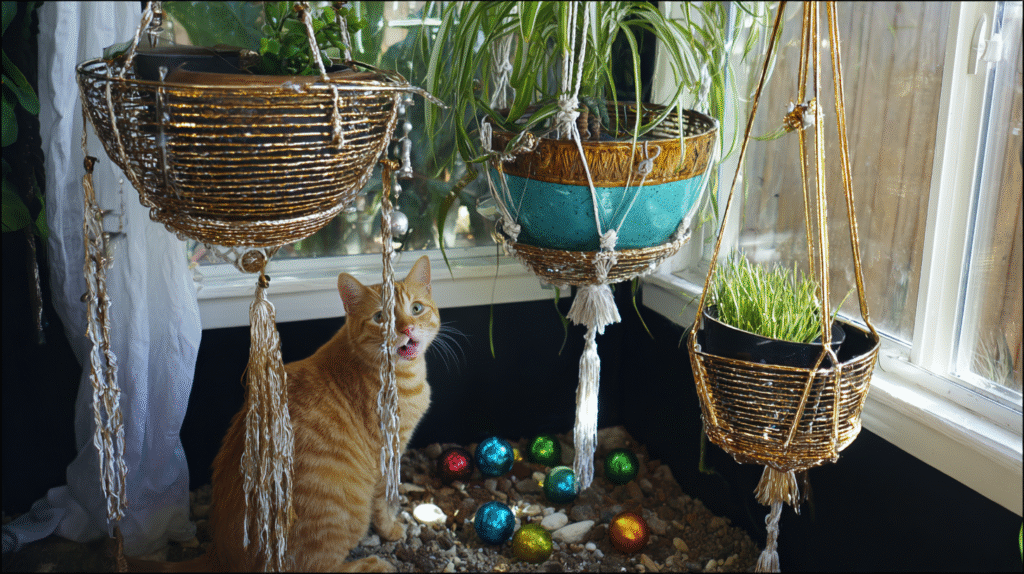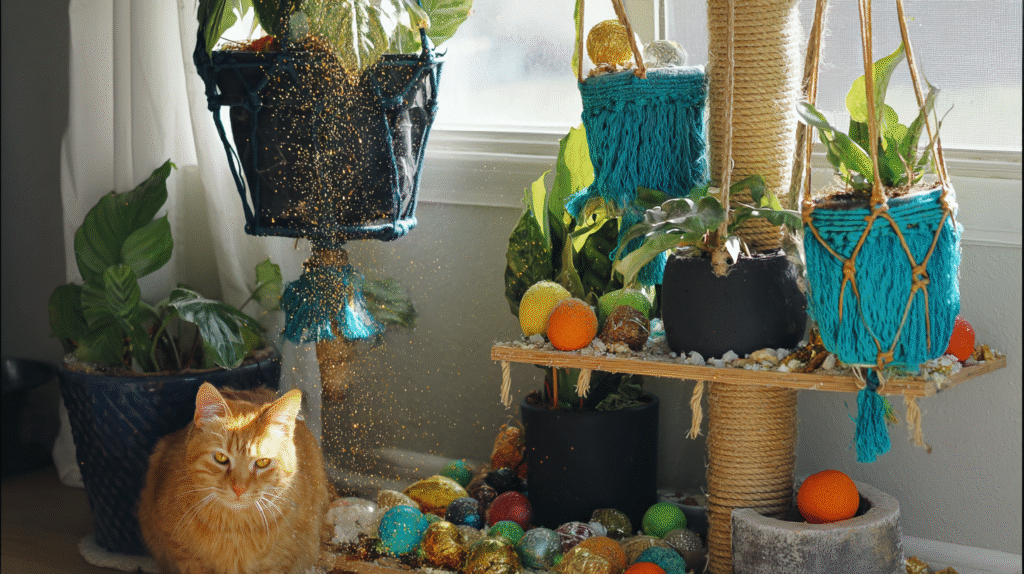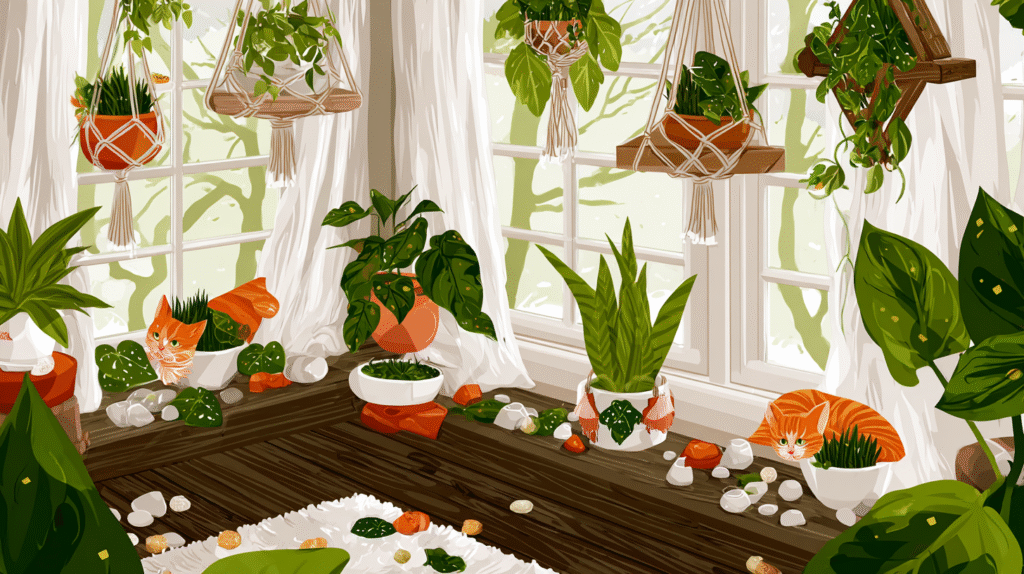Remember that scene in every plant parent’s life where you catch your cat mid-chew on your new monstera? Yeah, that was me. Except it wasn’t just once. My orange tabby, Cheese (don’t judge), systematically taste-tested every plant I brought home like he was writing Yelp reviews.
After one scary vet visit and a $300 bill (peace lily incident—never again), I went on a mission. Could I have plants AND a cat without turning my apartment into a danger zone? Spoiler alert: absolutely.
Two years later, I’m living in a certified jungle with 23 plants, and Cheese is alive, well, and occasionally still chomps my spider plant like it’s catnip. Here’s everything I learned about creating a cat-safe indoor garden that doesn’t look like you raided your grandma’s house.
Why Most “Pet-Safe” Lists Are Garbage
Let’s get real about those generic pet-safe plant lists floating around Pinterest. Half of them contradict each other, and the other half suggest plants that look about as exciting as cardboard. “Get a cast iron plant!” they say. Cool, I’ll put that right next to my collection of beige walls and sensible shoes.
Here’s what those lists don’t tell you: some “toxic” plants are mildly irritating (might cause drooling), while others are “rush to the emergency vet” toxic. Big difference. Also, “non-toxic” doesn’t mean “cat salad bar.” My spider plants are safe, but Cheese treats them like an all-you-can-eat buffet.
The Actually Good Cat-Safe Plants That Don’t Suck
Spider Plants (Chlorophytum comosum)
The gateway drug of cat-safe plants. Impossible to kill, grows like crazy, and cats go absolutely bonkers for them. Mine hangs from the ceiling, and Cheese still finds ways to nibble the babies. Pro tip: they’re basically cat grass. Your cat WILL eat them. Plan accordingly.
Boston Ferns (Nephrolepis exaltata)
Gorgeous, fluffy, and safe. Also humidity divas that’ll crisp up if you look at them wrong. I keep mine in the bathroom where the shower keeps it happy. Cheese likes to bat at the fronds but doesn’t eat them. Win-win.
Peperomia (All varieties)
These are the real MVPs. Tons of varieties, actually interesting to look at, and cats generally ignore them. I’ve got five different types. The watermelon peperomia looks fake it’s so perfect, and the ripple peperomia has these cool textured leaves. Cheese sniffed them once and never looked back.
Prayer Plants (Maranta leuconeura)
Drama queens that fold up their leaves at night like they’re praying (hence the name). Non-toxic and gorgeous with those painted-looking leaves. Fair warning: they’re particular about water. Use filtered or rain water unless you want crispy edges.
Ponytail Palms (Beaucarnea recurvata)
Looks like something Dr. Seuss designed. That bulbous base stores water, so it’s perfect if you forget to water sometimes (guilty). The long, grass-like leaves are irresistible to cats, but totally safe. Cheese uses mine as a personal back scratcher.
Money Tree (Pachira aquatica)
Not to be confused with the jade plant (which is toxic). These braided-trunk beauties are safe and supposedly bring good luck. Mine brought me a cat who doesn’t puke after eating it, so I’d say that’s lucky enough.

The Ones That Surprised Me
African Violets Grandma plants, right? Wrong. The new varieties come in crazy colors and patterns. Completely safe for cats, bloom constantly if you treat them right, and small enough to stick everywhere. I’ve got seven on my kitchen windowsill creating a purple explosion.
Orchids (Most varieties) I know, I know. Orchids have that “I’m too fancy for you” reputation. But moth orchids? Easier than you think AND cat-safe. The trick is ignoring them. Water once a week, give them indirect light, pretend they don’t exist otherwise. Mine blooms twice a year just to spite me.
Haworthia Like aloe vera’s cooler, non-toxic cousin. These little succulents look like alien artifacts and cats find them boring (perfect). They need barely any water and zero attention. I forget mine exists for weeks and it still looks amazing.
The Strategic Setup That Saved My Sanity
Here’s the thing: even safe plants can become cat toys if you’re not smart about placement. After finding dirt scattered across my couch one too many times, I developed a system.
The Hanging Garden Approach
Macrame hangers are your best friend. I’ve got six plants hanging at various heights where Cheese can see but not reach. Spider plants, boston ferns, and prayer plants all love the hanging life. Plus it looks incredibly cool, like an indoor rainforest.
The Shelf Defense
Floor plants are asking for trouble. Everything lives on shelves, plant stands, or mounted wall planters. My money tree sits on a tall plant stand that Cheese can’t climb (he’s tried). The peperomias line a shelf above my desk. Orchids perch on the bathroom shelf.
The Decoy Method
This is genius, if I do say so myself. I grow cat grass in multiple spots around the apartment. Cheese gets his greens, my plants stay intact. It’s like having a salad bar to distract from the main course.

My Hard-Learned Lessons
Lesson 1: Cats are individuals My friend’s cat completely ignores plants. Cheese thinks they’re interactive entertainment. Know your cat. Some are nibblers, some are diggers, some couldn’t care less.
Lesson 2: Texture matters Grass-like plants (spider plants, ponytail palms) are irresistible to most cats. Fuzzy or waxy leaves (peperomias, african violets) usually get ignored. Plan accordingly.
Lesson 3: The spray bottle is a lie Everyone says to spray your cat when they mess with plants. Cheese thought it was a fun game. Now I just design around his chaos.
Lesson 4: Dirt is a toy Covering soil with decorative stones stopped Cheese from treating my pots like litter boxes or dig sites. Game changer.
The Emergency Plan (Because Cats Gonna Cat)
Even with safe plants, keep this info handy:
- ASPCA’s poison control: (888) 426-4435
- Take a photo of any plant your cat chews
- Know your nearest emergency vet
- Keep activated charcoal on hand (ask your vet first)
Signs something’s wrong: excessive drooling, vomiting, lethargy, or acting weird. Don’t wait. Call the vet.

Real Questions From Real Cat Parents
My cat eats EVERYTHING. Can I have any plants? Start with grass. Seriously. Cat grass, wheatgrass, oat grass. If they’re gonna eat plants, give them ones designed for eating. Then try hanging plants way up high.
Are succulents safe? Some yes, some no. Haworthia and echeveria are safe. Jade plants and aloe vera are not. When in doubt, skip it.
What about herbs? Most kitchen herbs are safe! Basil, thyme, sage, cilantro. I grow them on my kitchen window. Cheese ignores them completely, probably because they’re actually meant to be eaten.
My cat digs in all my pots. Help? Decorative stones, aluminum foil, or those plastic spike mats made for gardens. Or do what I did and accept that some battles aren’t worth fighting. I just vacuum more now.
The Bottom Line
You can absolutely have a gorgeous plant collection and a cat. It just takes some strategy, the right plant choices, and accepting that your cat might occasionally nom a spider plant baby.
My apartment went from a plantless wasteland to a jungle paradise, and Cheese and I coexist peacefully (mostly). He gets his cat grass, I get my plant therapy, and nobody’s rushing to the emergency vet.
Start small. Grab a spider plant or a peperomia. See how your cat reacts. Build from there. Before you know it, you’ll be that person with the “crazy plant house” who also happens to have a very alive, very spoiled cat.
Just remember: when in doubt, hang it from the ceiling. Cats haven’t figured out levitation. Yet. 🌿






